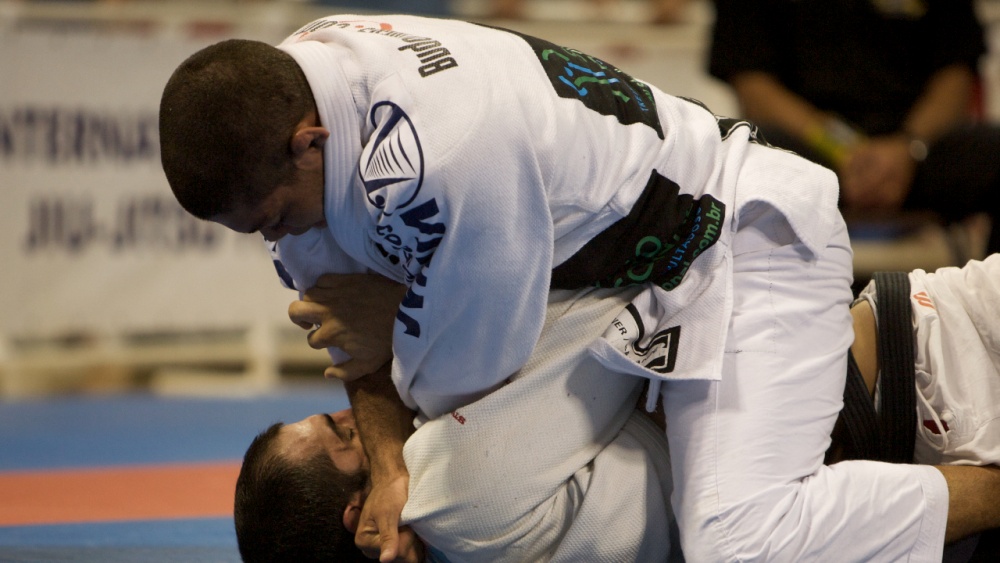One of the most satisfying things to do in the sport of Brazilian Jiu-Jitsu is to use the gi to either sweep or submit an opponent. The gi is the uniform you see in BJJ. It is made of solid fabric and is highly resistant to pulling and tugging. Using the gi as an extension of the body is legal in the sport. In fact, it is recommended to explore gi-specific techniques as it adds an added layer to your game. Today we’ll talk about one of Grandmaster Helio Gracie’s favorite techniques, the legendary cross choke.
What Is The Cross Choke?
The cross choke is a classic move in BJJ where you use the opponent’s gi against them. As the name suggests, it is characterized by crossing your arms as you grab the collar to force a submission. This choke focuses on putting pressure on the side of the neck, thereby restricting blood flow to the head.
The cross choke is a must for those who train in the gi. It teaches the basics of using your grips to slowly advance and threaten a submission. Since the cross choke is also applied from positions such as the mount and closed guard, it is a technique that is relatively safe to use as you’ll still be in a secure position if you can’t secure the tap.
Is The Cross Choke Easy To Learn?
Yes, it is! The cross choke is one of those techniques that’s easy to learn but can take years to master. It is actually one of the first techniques you’ll ever learn in your BJJ journey. It is a very common technique when you have the closed guard as you already have a cross collar grip on one side of the body.
As with any fundamental technique, the more you train with better and more experienced grapplers, the harder it is to successfully pull off the technique. Don’t fret! It is natural because they already know the typical counters to your attack. If you notice yourself struggling to use the cross choke in your rolls, it is a good idea to study its usual counters. Doing so enables you to think of ways to counter their defenses.
How To Perform The Cross Choke
In this video, Roger Gracie black belt Nic Gregoriades demonstrates the key concepts to the cross choke from mount. Roger Gracie’s run in the black belt division is the stuff of legends, and most of his high-profile submissions were variations of the cross choke.
To start, Nic mentions tucking your feet against the opponent’s hip to firmly attach your body to theirs. Next is to slightly open your knees as you relax your body. Doing this will sag your weight directly on your opponent’s torso, making you feel heavier instantly.
Once you have a stable mount, it’s now time to grab the collar. Nic suggests that you use your dominant hand for the initial grip. Open the lapel and slide your dominant hand underneath their arms.
Alternatively, you can also mirror your opponent’s top arm to slowly break the defense as you get your grip. Make sure that you get a deep grip, and your thumb should feel the back of your opponent’s neck.
As soon as you establish your initial grip, it’s now time to get the secondary grip. The best way to get the secondary grip is to first build a strong base. You can do this by using your head as a post to prevent the bridging escape. Post your head to the opposite side of your initial grip as you move in to get the other grip. Nic emphasizes the importance of getting solid grips as your opponent will do whatever it takes to remove them.
To finish the choke, move your elbows close to your body as you drop your weight towards their neck. Note that the secret to a successful cross choke is to not use your arm strength to force a tap; using your weight to tighten the choke is a stronger and more efficient way to get the submission.
Getting Comfortable With The Cross Choke
Many beginners are wary of using the cross choke, primarily because they get reversed most of the time. The bridging escape is a nice counter to the cross choke as it takes advantage of the fact that you don’t have a base on one side. Becoming comfortable with the cross choke takes repetition. You have to understand that each step of the technique requires careful precision and timing. Do not get greedy once you get the initial grip.
Remember that your opponent will always attempt the bridging escape as you try to get your secondary grip; therefore, you must first be as stable as possible so that you don’t get reversed. Stay alert and always be open to restarting your entry if your first few attempts are unsuccessful.
Talk to your instructor so that you’ll get first-hand feedback on your technique. It is expected that you’ll not be able to fully grasp a submission as nuanced as the cross choke in your first initial attempts.
Don’t get discouraged, and be open to criticism from your instructor and training partners. The gym is the best place to learn and hone techniques. Treat it as a laboratory where you can experiment and test moves against resisting opponents. If you are new to the cross choke, it is suggested that you drill the technique with no resistance. Slowly include the common reactions to the technique as you become more experienced.
Final Thoughts
The cross choke is a must-have for all grapplers who train in the gi. Many world champions have shown that the cross choke is applicable at the black belt level. As mentioned previously, it is a submission that is easy enough for white belts to learn by may take years of practice to fully master. Try out the cross choke, and let us know if it works for you!
You may also like:

















